Forte dei Marmi in literature
The verses of the greatest writers and artists who have recounted the wonder of this land
...We would swim in the waves morning and afternoon for hours, forgetting about Miss Parker’s rules. We used to go for very long walks on the beach by the sea, beyond the Forte pier towards the Ronchi: collecting shells, watching the crabs... it is that slightly salty freedom that Susanna Agnelli tells of in her Vestirevamo alla marinara, that slightly wild and ancient freedom that those who flock to the ever-exclusive shores of Forte still seek.
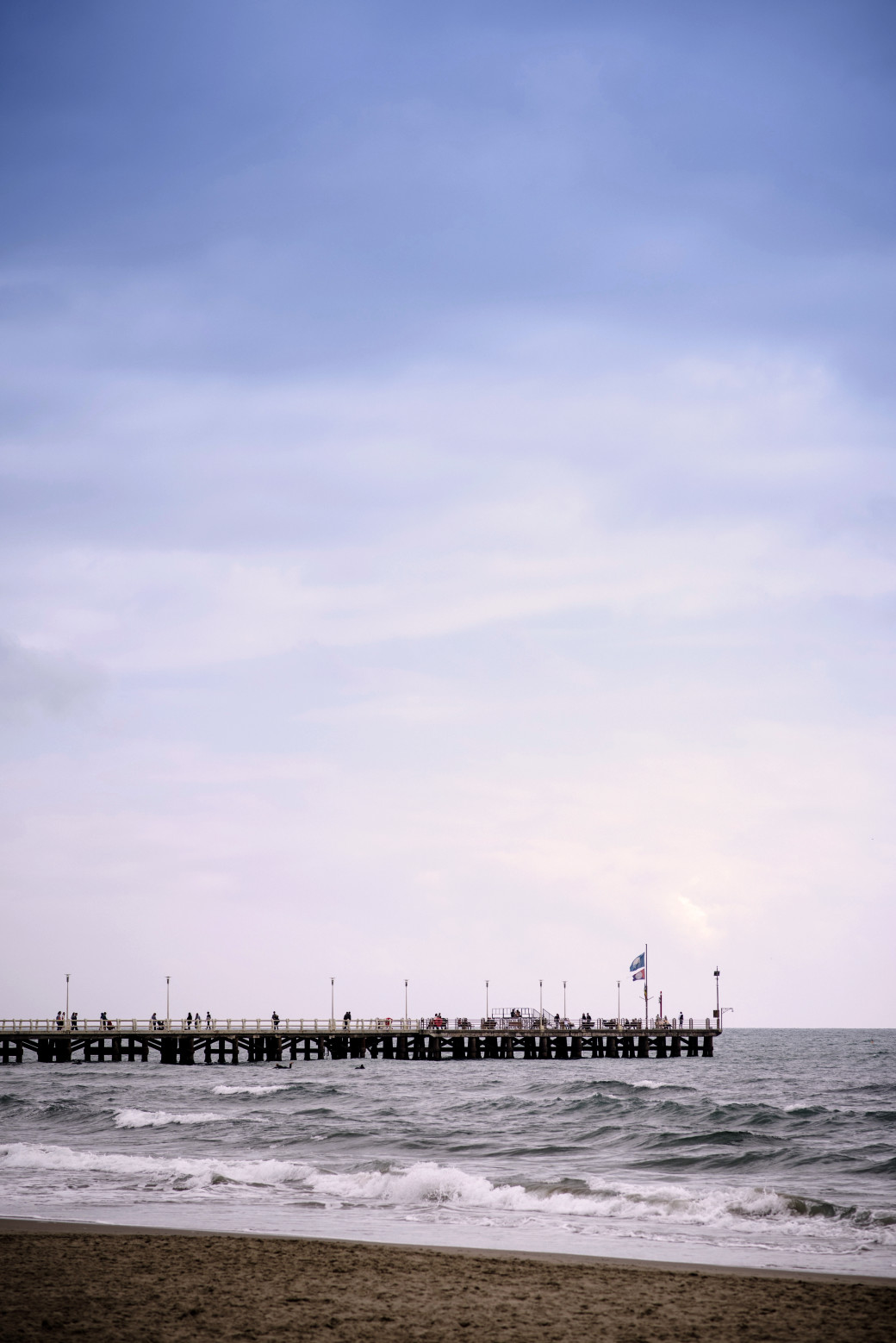 The Forte dei Marmi’s pier which is now a wharf, where from the days of Michelangelo the pure white blocks were shipped (ph. Pasquale Paradiso)
The Forte dei Marmi’s pier which is now a wharf, where from the days of Michelangelo the pure white blocks were shipped (ph. Pasquale Paradiso)A freedom protected by the unique confidentiality of the Fortemarmini people who guarded the secrets of Villa Costanza (home of the Agnelli family and now Hotel Augustus) where Suni’s mother was able to live out her love, with the Prato writer Curzio Malaparte, which was frowned upon by her ex-father-in-law..
He who, many years later in the 1950s, wanted to revive the coastline by opening the most chic club in Versilia right in the centre of Forte dei Marmi; in the writer from Prato’s plans, under the name Malaparte’s House or Chez Malaparte, it was to be the most luxurious nightclub ever to be seen in the area. But in the end it went no further than being a beautiful dream.
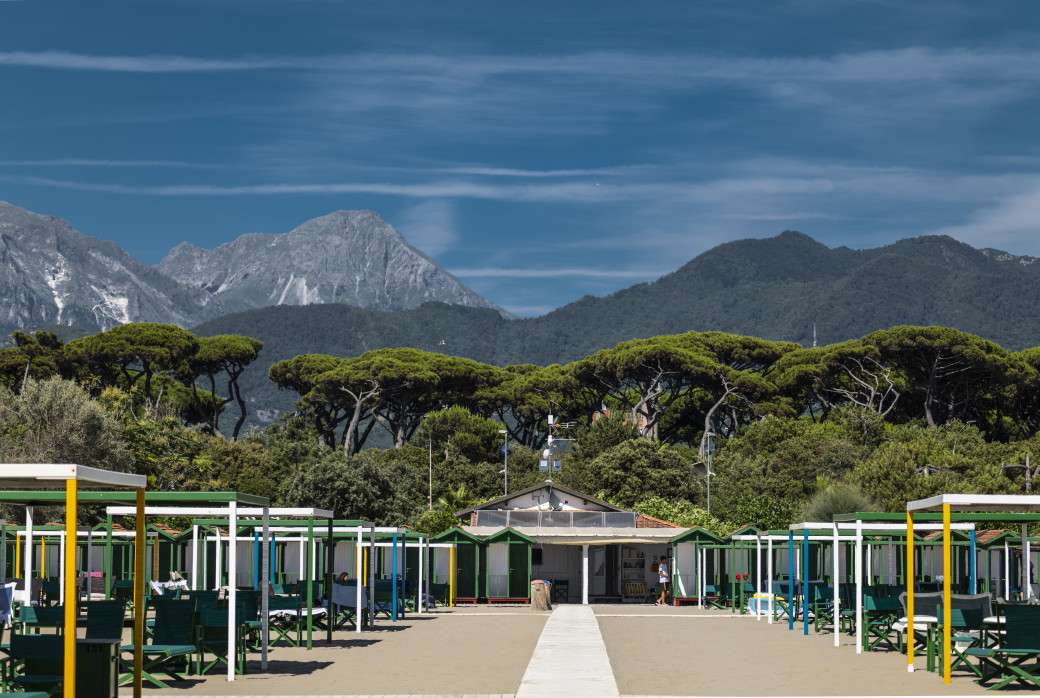 Bagno Piero and in the background the pine forest of Forte dei Marmi and the scenic mountain landscape of the Apuan Alps (ph. Lorenzo Cotrozzi)
Bagno Piero and in the background the pine forest of Forte dei Marmi and the scenic mountain landscape of the Apuan Alps (ph. Lorenzo Cotrozzi)On a literary note, even the supreme Pier Paolo Pasolini, left us an immortal description of the Apuan Alps that stand out behind Versilia and Forte, codifying its imagery in La lunga strada di Sabbia which was published in 1959: Are the mountains of Versilia laughing or gloomy? This is one thing you can never wrap your head around. They are a little wild in shape and are always imbued with end-of-the-world hues, with pink, dry flashes of marble seeping through as if by chance.
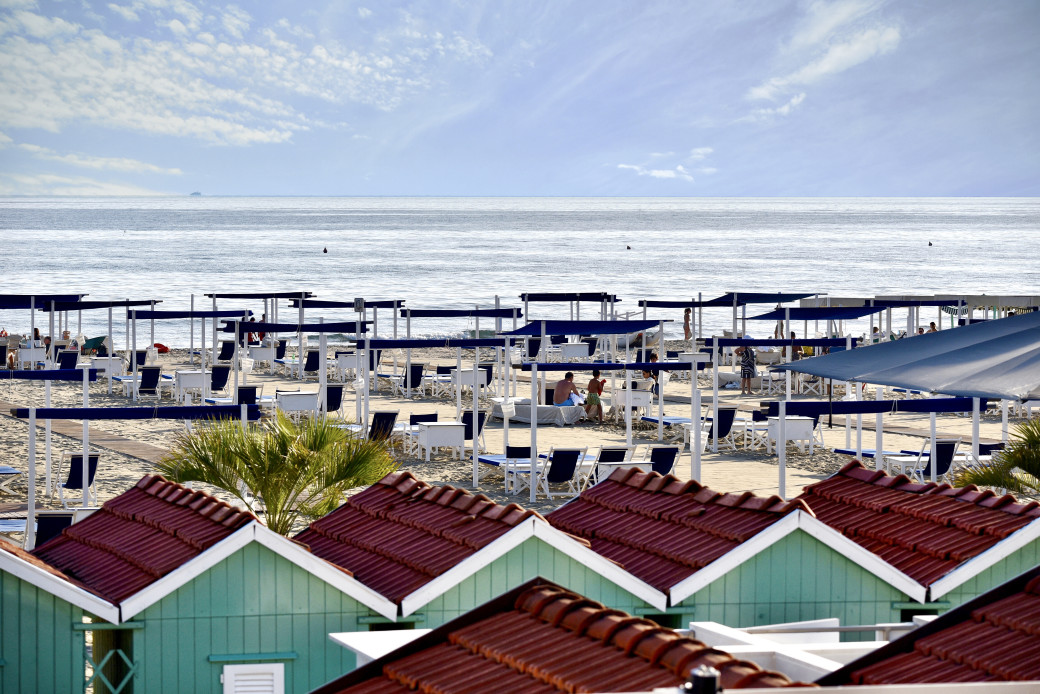 Le cabine tradizionali in legno colorato simbolo delle vacanze estive a Forte dei Marmi (ph. Ornella Burchianti)
Le cabine tradizionali in legno colorato simbolo delle vacanze estive a Forte dei Marmi (ph. Ornella Burchianti)Going further back amidst memories and recollections, the dunes re-emerge, as does the pier which is now a wharf, where from the days of Michelangelo the pure white blocks were shipped. We must not forget the salty and burnt tamarisks and the shining broom trees from the nearby Marina di Pietrasanta pine forest that had enchanted Gabriele D’Annunzio 60 years earlier, together with the primordial beauty of this area where the Prophet often resided to be closer to his lover, the actress Eleonora Duse. D’Annunzio had been so attracted by this wild and unspoilt landscape that he dedicated an entire collection of poems to it: Alcyone.
The enlightened and pleasure-loving Pietro Leopoldo Lorena must have had an ambitious project in mind when, between the 18th and 19th centuries, he reorganised the ancient Mediterranean maquis by reclaiming the marshy areas and crowning them with pine forests and wide sandy shores, which were extremely appealing to the aristocrats of half of Europe. This is not to mention Giacomo Puccini who pulled in musicians and writers, painters and sculptors. In fact, it is no coincidence that Leonida Répaci brought the Viareggio Prize into being in the late 1920s. And it was in Forte dei Marmi that Maria Bellonci touched on the idea 30 years later, while hanging out at the Caffè Quarto Platano, for the prestigious Strega Prize.
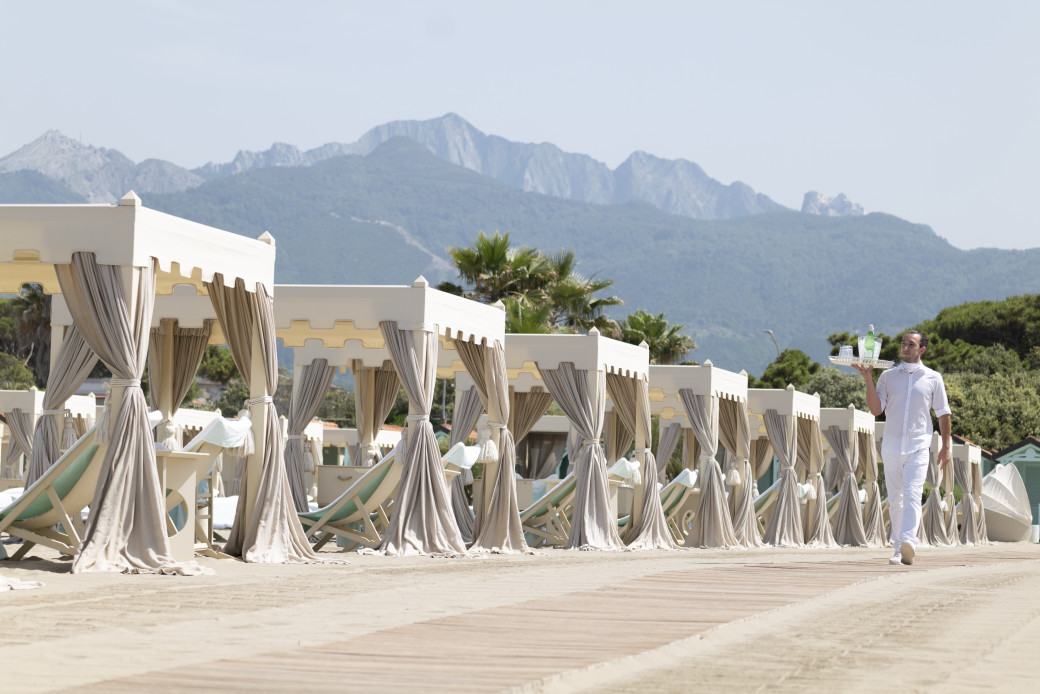 Sand, wood, natural fabrics and soft colors... this is the elegant grammar of Bagno Alpemare (ph. Lorenzo Cotrozzi)
Sand, wood, natural fabrics and soft colors... this is the elegant grammar of Bagno Alpemare (ph. Lorenzo Cotrozzi)After all, Versilia, to borrow Genovesi’s words, everyone knows it because everyone has been there at least once in their life. In fact, since the 19th century and before it became a seaside resort, it was loved by artists, nobles and writers who took up residence here. From Pirandello to Galileo Chini, from Nomellini to Viani, Soffici, Montale and again Pea and Pratolini, Gadda and Bontempelli to Mann and Huxley who would meet at aperitif time in the shade of the plane trees in Piazza Garibaldi.
It is here that Enrico Pea started his literary salon, Il Quarto Platano (nowadays known as Caffè Roma), which is about to be transformed into a museum (in Villa Bertelli).
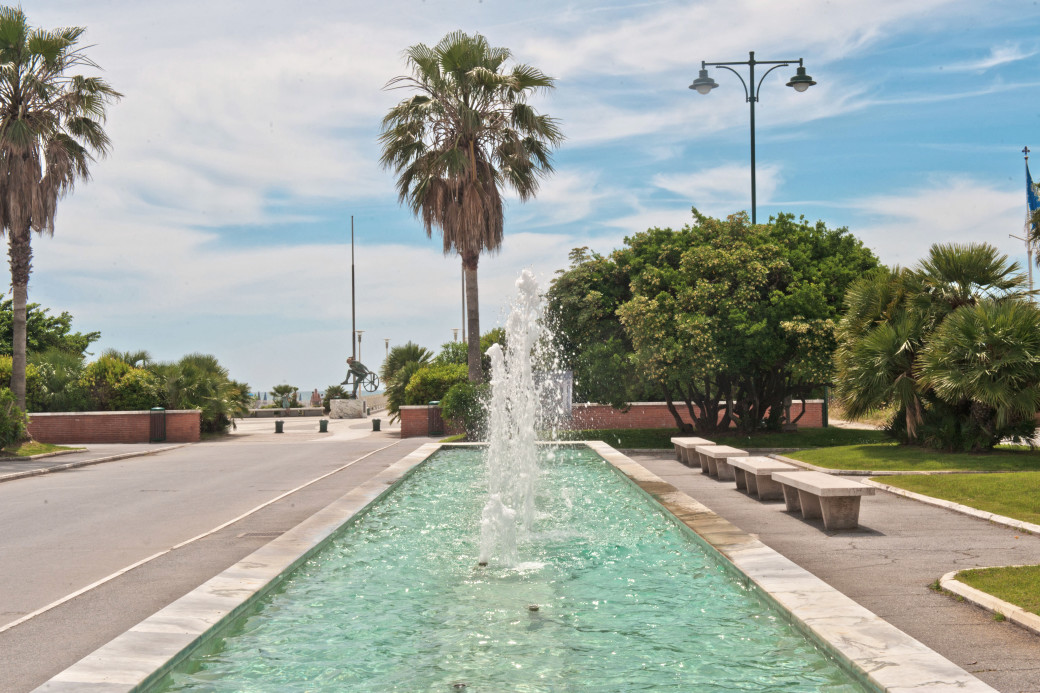 The two well-kept gushing fountains made of white Carrara marble in front of the Forte dei Marmi’s pier (ph. Dario Garofalo)
The two well-kept gushing fountains made of white Carrara marble in front of the Forte dei Marmi’s pier (ph. Dario Garofalo)Lived or fictionalised life was read under the parasol, even going back slightly to the late 1950s. Timid, reserved, a little awkward, Andreana, the daughter of a newly rich man, would be found on the exclusive beach of Forte watching from afar as a gilded youth spent its time at exclusive parties, pleasurable nights at the Capannina, racing in a Maserati or on a speedboat. She was unexpectedly accepted... tells Antonella Boralevi in her timeless Prima che il vento.
Clearly, those were the years when nobody would have thought that the economic boom would not last forever and that wars are always lurking about the background. As Sandro Veronesi suggests in Venite venite B52. There he tells of tormented young people in the 1980s against the backdrop of military planes bursting through the skies over Versilia almost touching the crests of the Procinto, Pizzo d’Uccello or the Forato... come here, throw the bomb here, come sweep everything away, said Viola... in front of his eyes, bluer than his eyes, the upper Tyrrhenian drew a clear horizon...
And if Dario Ferrari with his La ricreazione è finita investigates the precariousness of young researchers within the intrigues and mysteries of a Versilia that is not completely kind with light-hearted humour, Fabio Giannotti is the one with a truly noir vein, who between autobiographical and fantasy wears the guise of the journalist Pompilio Nardini in Giallo Versilia. Spy and detective stories that in the new millennium have been inaugurated by the Versilian Giampaolo Simi, the author of detective stories for TV too such as the series Nero a metà. Even if under the beach umbrella it is more intriguing to follow La ragazza sbagliata or L’estate di Piera or, thinking of the sea in winter ... the schools stayed closed for the rest of the week allowing students to turn their body surfboards into sledges... on the afternoon of that 14 February as much as 46 centimetres of snow covered Versilia... he writes in Cosa resta di noi. Indeed, there is always an ironic or tragicomic aspect to the adventures and misadventures of the characters who populate a Versilia of contradictions and pitfalls like its sea of sand. As Aldo Valleroni pointed out in the milestone that is Versilia anni ruggenti. And they inspire authors such as the entrepreneur and politician from Prato Edoardo Nesi who investigates society with Storia della mia gente or fughe da fermo. Or the bubbly Jessica Franchi who recounts the holidays of a ramshackle third-millennium family with Se è maschio si chiama Gino.
Then there is the prolific Fabio Genovesi who always sets his novels in Versilia, such as Il calamaro gigante or Il mare dove non si tocca or, just to remain suspended between reality and fiction... Elisabetta Sottili with Senti che vento. And if we really wanted to delve into the past, Pea’s Moscardino is a classic of post-war literature. Where the mollusc is just a nickname for a young boy struggling with life’s difficulties.










